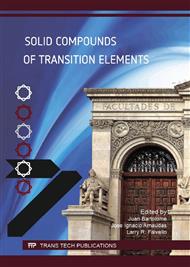[1]
G.J. Snyder, E.S. Toberer, Complex thermoelectric materials, Nat. Mater. 7 (2008) 105-114.
Google Scholar
[2]
T. Takabatake, K. Suekuni, T. Nakayama, E. Kaneshita, Phonon-glass electron-crystal thermoelectric clathrates: Experiments and theory, Rev. Mod. Phys. 86 (2014) 669-716.
DOI: 10.1103/revmodphys.86.669
Google Scholar
[3]
C.J. Vineis, A. Shakouri, A. Majumdar, M.G. Kanatzidis, Nanostructured thermoelectrics: Big efficiency gains from small features, Adv. Mater. 22 (2010) 3970-3980.
DOI: 10.1002/adma.201000839
Google Scholar
[4]
M.W. Gaultois, T.D. Sparks, How much improvement in thermoelectric performance can come from reducing thermal conductivity?, Appl. Phys. Lett. 104 (2014) 113906.
DOI: 10.1063/1.4869232
Google Scholar
[5]
C.B. Vining, An inconvenient truth about thermoelectrics, Nat. Mater. 8 (2009) 83-85.
Google Scholar
[6]
H. -S. Kim, Z.M. Gibbs, Y. Tang, H. Wang, G.J. Snyder, Characterization of Lorenz number with Seebeck coefficient measurement, APL Mat. 3 (2015) 041506.
DOI: 10.1063/1.4908244
Google Scholar
[7]
M.W. Gaultois, T.D. Sparks, C.K.H. Borg, R. Seshadri, W.D. Bonificio, D.R. Clarke, Data-driven review of thermoelectric materials: Performance and resource considerations, Chem. Mater. 25 (2013) 2911-2920.
DOI: 10.1021/cm400893e
Google Scholar
[8]
H.J. Goldsmid, J.W. Sharp, Estimation of the thermal band gap of a semiconductor from seebeck measurements, J. Electron. Mater. 28 (1999) 869-872.
DOI: 10.1007/s11664-999-0211-y
Google Scholar
[9]
L.D. Hicks, M.S. Dresselhaus, Effect of quantum-well structures on the thermoelectric figure of merit, Phys. Rev. B, 47 (1993) 12727-12731.
DOI: 10.1103/physrevb.47.12727
Google Scholar
[10]
L.D. Hicks, M.S. Dresselhaus, Thermoelectric figure of merit of a one-dimensional conductor, Phys. Rev. B, 47 (1993) 16631-16634.
DOI: 10.1103/physrevb.47.16631
Google Scholar
[11]
M. Maldovan, Sound and heat revolutions in phononics, Nature, 503 (2013) 209-217.
DOI: 10.1038/nature12608
Google Scholar
[12]
L. Yang, N. Yang, B. Li, Reduction of thermal conductivity by nanoscale 3D phononic crystal, Sci Rep. 3 (2013) 1143.
DOI: 10.1038/srep01143
Google Scholar
[13]
L. Yang, N. Yang, B. Li, Extreme low thermal conductivity in nanoscale 3D Si phononic crystal with spherical pores, Nano Lett., 14 (2014) 1734-1738.
DOI: 10.1021/nl403750s
Google Scholar
[14]
G. Chen, Nanoscale energy transport and conversion: a parallel treatment of electrons, molecules, phonons, and photons, Oxford University Press, Inc., New York, 2005. .
Google Scholar
[15]
Y. Xu, M. Goto, R. Kato, Y. Tanaka, Y. Kagawa, Thermal conductivity of ZnO thin film produced by reactive sputtering. J. Appl. Phys. 111 (2012) 084320.
DOI: 10.1063/1.4706569
Google Scholar
[16]
R.M. Costescu, D.G. Cahill, F.H. Fabreguette, Z.A. Sechrist, S.M. George. Ultra-low thermal conductivity in W/Al2O3 nanolaminates, Science, 303 (2004) 989-990.
DOI: 10.1126/science.1093711
Google Scholar
[17]
C. Chiritescu, D.G. Cahill, N. Nguyen, D. Johnson, A. Bodapati, P. Keblinski, P. Zschack, Ultralow thermal conductivity in disordered, layered WSe2 crystals, Science, 315 (2007) 351-353.
DOI: 10.1126/science.1136494
Google Scholar
[18]
T.C. Harman, P.J. Taylor, M.P. Walsh, B.E. LaForge, Quantum dot superlattice thermoelectric materials and devices, Science, 297 (2002) 2229-2232.
DOI: 10.1126/science.1072886
Google Scholar
[19]
N. Satoh, Soft matter assembly for atomically precise fabrication of solid oxide, in: X. Chen, H. Fuchs (Eds. ), Soft Matter Nanotechnology, Wiley-VCH, Weinheim, 2015, pp.217-232.
DOI: 10.1002/9783527682157.ch08
Google Scholar
[20]
M.V. Wolkin, J. Jorne, P.M. Fauchet, G. Allan, C. Delerue, Electronic states and luminescence in porous silicon quantum dots: the role of oxygen. Phys. Rev. Lett. 82 (1999) 197-200.
DOI: 10.1103/physrevlett.82.197
Google Scholar
[21]
N. Satoh, T. Nakashima, K. Kamikura, K. Yamamoto, Quantum size effect in TiO2 nanoparticles prepared by finely controlled metal assembly on dendrimer templates, Nat. Nanotechnol. 3 (2008) 106-111.
DOI: 10.1038/nnano.2008.2
Google Scholar
[22]
N. Satoh, T. Nakashima, K. Yamamoto, Metastability of anatase: Size dependent and irreversible anatase-rutile phase transition in atomic-level precise titania, Sci. Rep. 3 (2013) (1959).
DOI: 10.1038/srep01959
Google Scholar
[23]
S.M. George, Atomic layer deposition: an overview, Chem. Rev. 110 (2010) 111-131.
Google Scholar
[24]
T.J. Abraham, D.R. MacFarlane, J.M. Pringle, High Seebeck coefficient redox ionic liquid electrolytes for thermal energy harvesting. Energy Environ. Sci. 6 (2013) 2639-2645.
DOI: 10.1039/c3ee41608a
Google Scholar
[25]
N. Satoh, Insight from molecular-scale electron transfer to small-scale electronics, Chem. Lett. 43 (2014) 629-630.
DOI: 10.1246/cl.131185
Google Scholar
[26]
J. Ferraris, D.O. Cowan, V. Walatka, J.H. Perlstein, Electron transfer in a new highly conducting donor-acceptor complex. J. Am. Chem. Soc. 95 (1973) 948-949.
DOI: 10.1021/ja00784a066
Google Scholar
[27]
H. Hosono, N. Kikuchi, N. Ueda, H. Kawazoe, Working hypothesis to explore novel wide band gap electrically conducting amorphous oxides and examples, J. Non-Cryst. Solids, 198-200 (1996) 165-169.
DOI: 10.1016/0022-3093(96)80019-6
Google Scholar


